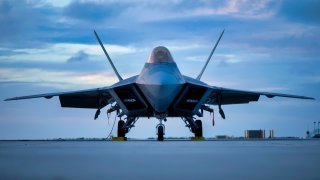The F-22 Has 1 Problem That Is Impossible to Fix
In 2009, Congress, influenced by President Obama, halted additional funding for the F-22 Raptor, a decision driven by a shift in defense priorities post-Cold War. The F-22, renowned for its stealth, supermaneuverability, and air superiority, was initially intended to counter Soviet threats.
Summary and Key Points: In 2009, Congress, influenced by President Obama, halted additional funding for the F-22 Raptor, a decision driven by a shift in defense priorities post-Cold War. The F-22, renowned for its stealth, supermaneuverability, and air superiority, was initially intended to counter Soviet threats.

-However, with the rise of fifth-generation fighters from China and Russia, analysts now question the wisdom of curtailing Raptor production.
-The F-22, with its superior radar cross-section, thrust vectoring, and advanced weaponry, remains unmatched in dogfights, highlighting the missed opportunity to bolster U.S. air superiority in today’s volatile geopolitical climate.
Could More F-22 Raptors Have Secured America's Air Superiority Today?
Barack Obama once asserted that he rejected “the notion that we have to waste billions of taxpayer dollars on outdated and unnecessary defense projects to keep this nation secure” regarding the F-22 fighter jet program. Perhaps in hindsight, the former U.S. president would change his tune, considering the current threat climate today.
When the F-22 Raptor was first introduced to service, it represented the premiere fifth-generation fighter platform to ever fly the skies. The stealth platform immediately provided air superiority to the U.S., as its adversaries were still fielding fourth-generation counterparts.
Despite the Raptor’s impressive attributes, the end of the Cold War and shift to the War on Terror in the Middle East made some officials question the significance of the fighter. Ultimately, funding for the initially planned 750 Raptors was cut short.
What happened to the F-22?
In 2009, Congress narrowly voted to cut funding for additional F-22 fighter jets. This vote came one day after then-president Obama threatened to use his veto power for the first time as part of his administration’s efforts to shift defense spending away from major weapons programs deemed as unnecessary.
As stated by then-Secretary of Defense Robert Gates, additional Raptors “no longer reflected contemporary wartime needs.”
The F-22 was originally intended to go up against the Soviet Union’s own fighter jets in dogfights, however, the collapse of the USSR obviously impacted the platform’s potential role in that specific combat scenario.
Some proponents of the F-22 alluded that the F-22 could be exported to friendly nations in order to make up for the fighters’ high associated costs. Years earlier, a 1998 defense appropriations bill was passed prohibiting the sale of the Raptor to other nations.
U.S. officials were concerned that the F-22’s unparalleled technology could be stolen by adversaries down the line and for this reason has blocked any sales.
While this decision may have made sense during this time period, the current threat climate has some analysts wondering whether curtailing Raptor procurement was the right call. The U.S. is no longer the only country to field fifth-generation platforms.

China and Russia have both produced their own Raptor counterparts- the Chengdu J-20 and the Sukhoi Su-57 respectively.
Although the U.S. has introduced the F-35 Lightning II, a platform widely considered to be the best jet to fly the skies today, the new fighter still comes in second to the Raptor when it comes to certain capabilities.
Introducing the F-22 and its specs/capabilities
The F-22 was notably the first platform to combine supermaneuverability, super cruise and stealth in a single airframe.
From its smaller radar-cross section and fast speed to its armament-lugging capacity and dog-fighting prowess, the F-22 has rightfully achieved legendary status among military experts and aviation buffs alike. Its radar cross section is even smaller than the F-35 Lightning II’s, making the jet extremely difficult for enemy aircraft to detect.
In terms of weaponry, the fighter can carry air-to-air and air-to-ground weapons, including the Joint Direct Attack Munitions and precision-guided ground bombs. Additionally, the F-22 can lug six AIM-120 AMRAAMS and two AIM-9 Sidewinders when in its air-to-air configuration.
Sandboxx News has outlined how the Raptor can outperform any other fighter in aerial combat: “What makes the F-22 great in a dogfight is the aircraft’s thrust vectoring capabilities. Its two engines have specially designed nozzles at their ends that can move on a vertical plane to vector the aircraft’s 70,000 pounds of thrust in one direction even if the aircraft is heading in another, thus allowing the F-22 to do some impressive acrobatics, as well as leverage an extremely high angle of attack during a within-visual-range engagement (a dogfight).”
The F-22 Is Needed Now More Than Ever
As tensions continue to escalate between Beijing and Washington, the potential for a kinetic conflict increases. The U.S. no longer retains quite the same level of air superiority as it did back in the day. Additionally, the People’s Republic of China is rapidly developing its fleet of J-20 fighters.
Today, analysts believe Beijing already has 200 of these fifth-gen jets in service. While the U.S. has more than double this number in F-35s, obviously China is catching up. If the U.S. procured a few hundred more Raptors back in the day, perhaps our Air Force would be better positioned to fight against China if war broke out tomorrow.
About the Author: Maya Carlin
Maya Carlin, National Security Writer with The National Interest, is an analyst with the Center for Security Policy and a former Anna Sobol Levy Fellow at IDC Herzliya in Israel. She has by-lines in many publications, including The National Interest, Jerusalem Post, and Times of Israel. You can follow her on Twitter: @MayaCarlin.
Image Credit: Creative Commons and/or Shutterstock.


